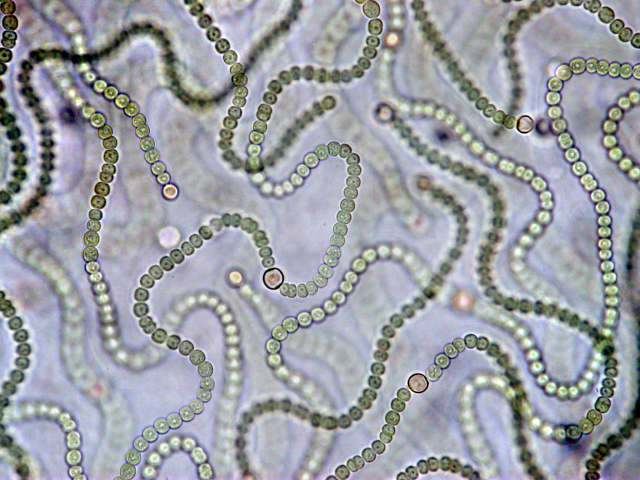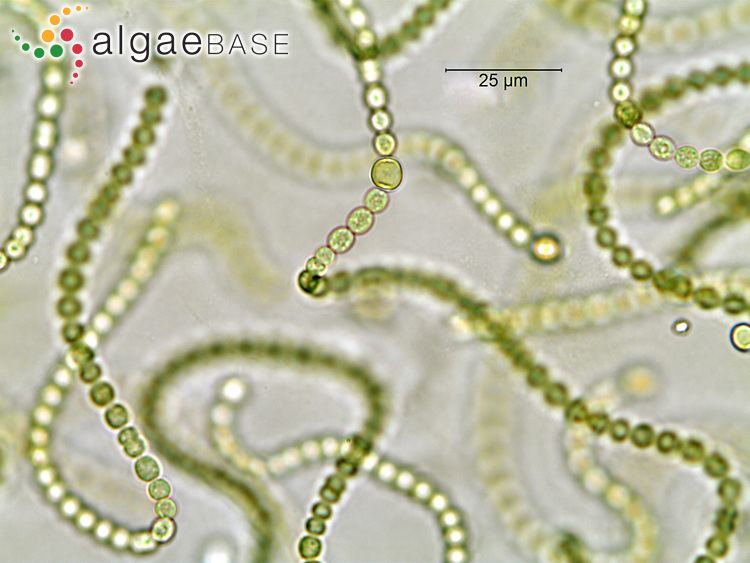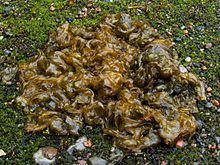Kingdom Eubacteria Genus Nostoc Higher classification Nostoc | ||
Similar Nostoc, Blue‑green bacteria, Bacteria, Nostocales, Anabaena | ||
Nostoc commune microscoping video wmv
Nostoc commune is a species of cyanobacterium in the family Nostocaceae. Common names include star jelly, witch's butter, mare's eggs, fah-tsai and facai. It is the type species of the genus Nostoc and is cosmopolitan in distribution.
Contents
- Nostoc commune microscoping video wmv
- Nostoc commune fungi kingdom
- Description
- Distribution and habitat
- Biology
- Uses
- References

Nostoc commune fungi kingdom
Description
Nostoc commune is a colonial species of cyanobacterium. It initially forms a small, hollow gelatinous globule which grows and becomes leathery, flattened and convoluted, forming a gelatinous mass with other colonies growing nearby. Inside the thin sheath are numerous unbranched hair-like structures called trichomes formed of short cells in a string. Cells have no nucleus nor internal membrane system. To multiply, they form two new cells when they divide by binary fission. Along the trichomes, larger specialist nitrogen-fixing cells called heterocysts occur between the ordinary cells. When wet, Nostoc commune is bluish-green, olive green or brown but in dry conditions it becomes an inconspicuous, crisp brownish mat.
Distribution and habitat

Nostoc commune is found in many countries around the world. It is able to survive in extreme conditions in polar regions and arid areas. It is a terrestrial or freshwater species and forms loose clumps on soil, gravel and paved surfaces, among mosses and between cobbles. In Singapore, Nostoc commune is found growing on alkaline soils, in brackish water, in paddy fields, on cliffs and on wet rocks.
Biology

Nostoc commune can fix nitrogen from the atmosphere and can therefore live in locations where no nitrogenous compounds are available from the substrate. Nostoc commune does not have chloroplasts but contains photosynthetic pigments in the cytoplasm of the cells. It also contains pigments that absorb long and medium wavelength ultraviolet radiation, which enables it to survive in places with high levels of radiation.

Under adverse conditions, Nostoc commune can remain dormant for an extended period of time and revive when conditions improve and water becomes available. The desiccated colony is resistant to heat and to repeated patterns of freezing and thawing and produces no oxygen while dormant. It has been found that extracellular polysaccharides are vital to its stress tolerance and ability to recover.
Nostoc commune can occur in pockets in the thallus of hornworts such as Phaeoceros.
Uses
Nostoc commune is eaten as a salad in the Philippines and is also eaten in Indonesia, Japan and Taiwan. In Taiwan, it is nicknamed 雨來菇 yǔ lái gū (meaning "post-rain mushroom"). Nostoc commune var. flagelliforme is known as 发菜 fàcài in China which forms part of the food traditionally served at the Lunar New Year. Research indicates that consumption of Nostoc commune var. sphaeroides, in addition to consumption of other cyanobacteria may be beneficial by means of an anti-inflammatory mechanism.
